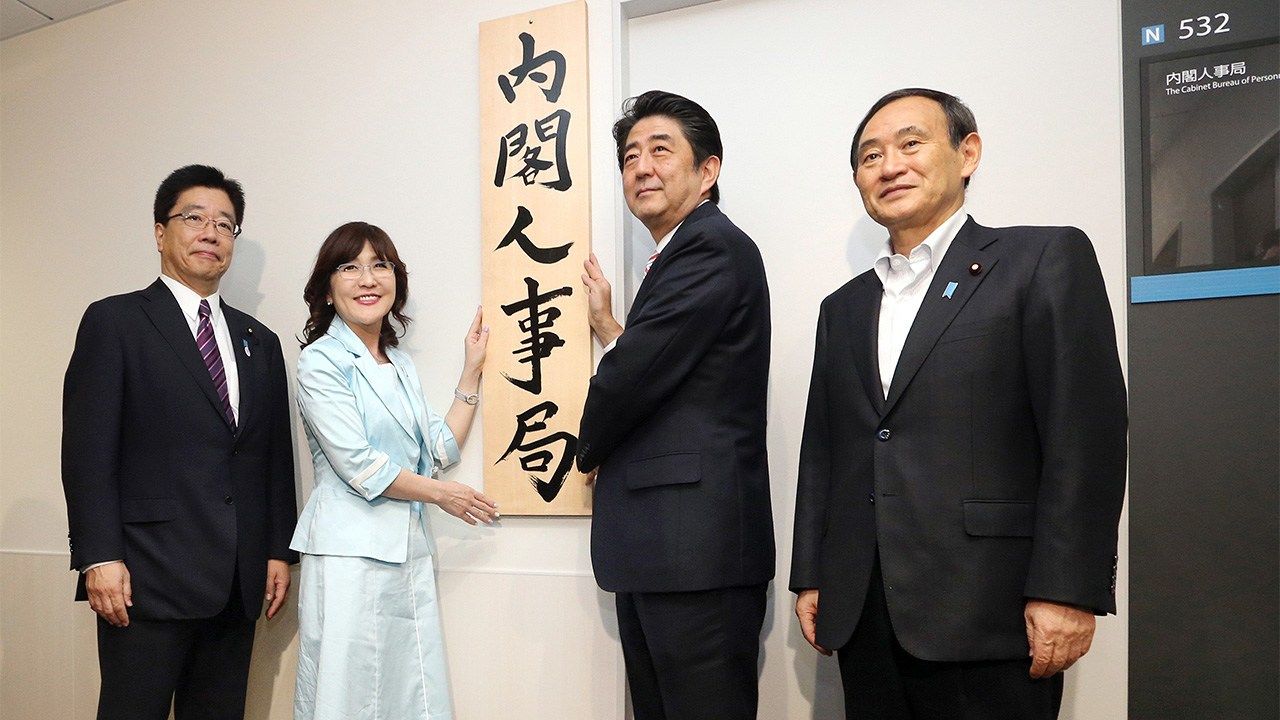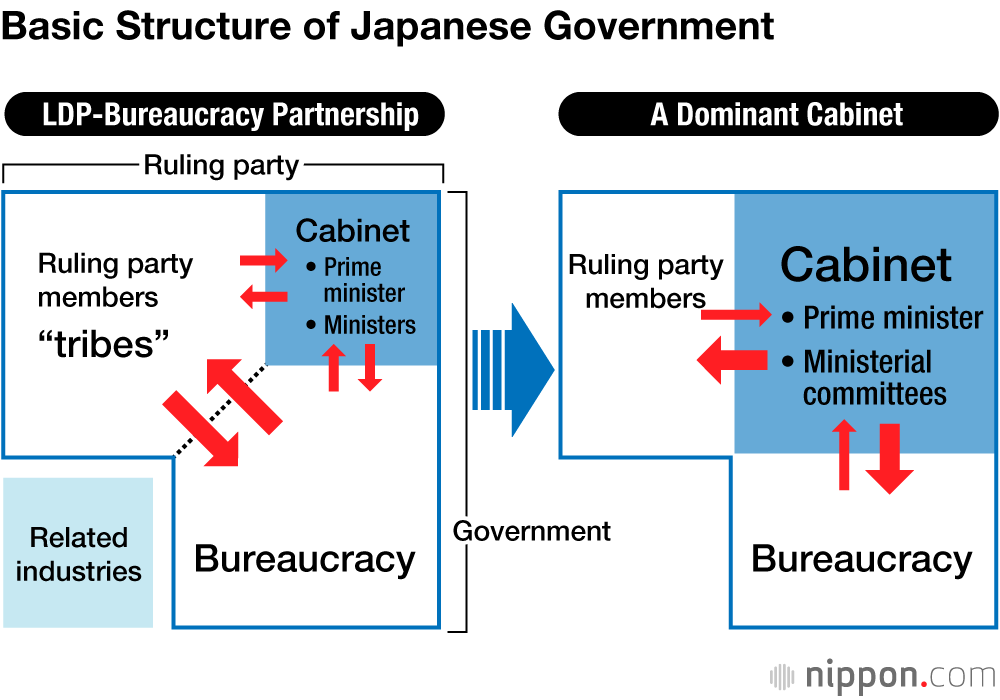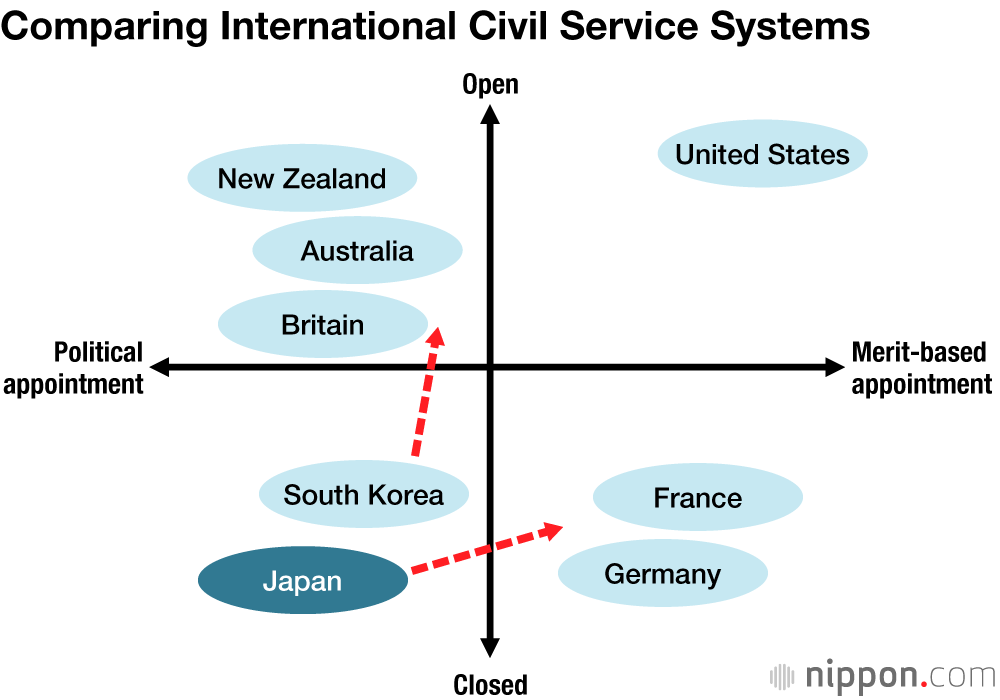
Japan’s Problematic Administrative Reform: A Plea for Neutral Policymaking
Politics- English
- 日本語
- 简体字
- 繁體字
- Français
- Español
- العربية
- Русский
In Japan, it has become conventional wisdom that the nation’s political leaders should dominate the policymaking process; the concept of “bureaucratic leadership” (kanryō shudō) has taken on distinctly negative connotations. But back in the heyday of Japanese economic growth, many experts (particularly Western analysts) saw the policymaking power and prowess of Japan’s elite administrators as an important factor behind the country’s rapid development after World War II. In his 1979 bestseller Japan as Number One, Harvard University Professor Ezra Vogel cited capable bureaucratic leadership as one of the keys to Japan’s emergence as “the world’s most effective industrial power.”
Then, in the 1990s, the collapse of the asset bubble—ushering in years of economic stagnation—along with a series of government corruption scandals, irreparably tarnished the image of the Japanese bureaucrat. Japan’s sectionalist bureaucracy came under fierce criticism, spurring a succession of wide-ranging reforms designed to strengthen the power of the prime minister and his staff over government decision making.
In the following, I trace those reforms and offer an assessment of the outcome, with a focus on the relationship between politicians and administrators. But first, let us undertake a brief overview and analysis of that relationship as it evolved under the political dominance of the Liberal Democratic Party, which governed continuously from 1955 to 1993.
The Bureaucracy and the LDP
The left-hand portion of the chart below illustrates the basic structure of government decision making prior to the administrative reforms implemented from 2001 on. The salient feature is the relatively small role of the cabinet (in which executive power is invested under the Constitution) under the LDP-bureaucracy partnership.
The central job of the government is to draft and implement public policy, and to do so, it must pass the necessary laws. In Japan, such legislation is traditionally drafted within the administrative agency that has jurisdiction, approved by a unanimous cabinet decision, and then submitted to the Diet for deliberation and action. But without broad agreement on the bill within the majority party, the process is likely to stall in the Diet. To avoid endless delays of this sort, an extralegal mechanism known as “prior review” was developed. Under this system, each bill must be vetted and approved by the appropriate division of the LDP Policy Research Council, as well as by the LDP General Council, before it is adopted by the cabinet and submitted to the Diet.
Of course, some degree of advance consultation with the ruling party occurs in other democratic countries as well. In Japan, however, prior review took the place of the revision process that normally occurs within the legislature; LDP politicians made all the revisions they needed before the bill was submitted to the Diet. As a result, parliamentary deliberation became a bit of a charade, an opportunity for the opposition to shout its objections before a bill’s inevitable passage.
During the period of uninterrupted LDP rule, policymaking was dominated by the “iron triangle” of ties between individual government agencies, “tribes” of LDP politicians, and industry groups. High-level bureaucrats played a pivotal role in this relationship, ironing out differences and building consensus, and this led observers to conclude that the bureaucracy controlled the policymaking process. However, as demonstrated by J. Mark Ramseyer and Frances M. Rosenbluth in their 1997 book Japan’s Political Marketplace, prior review made “veto players” out of LDP politicians representing key interest groups. While the LDP left the nuts and bolts to the ministry bureaucrats, its ranking politicians had the power to block or eviscerate policies that ran counter to their interests. Rather than kanryō shudō, I prefer to think of this system as the “LDP-bureaucracy diarchy.”
The Path to Political Leadership
On the whole, this setup functioned effectively from the period of postwar reconstruction up through the era of rapid economic growth. Of course, the partnership fostered problems as well, particularly an unhealthy relationship between government bureaucrats and the industries they were supposed to regulate. But at a time when the country was suffering from a critical shortage of public infrastructure, what was good for industry was, in the main, good for the nation.
The system’s shortcomings became more apparent, however, as Japan transitioned to a mature economy, and especially after the collapse of the 1980s bubble. One problem was that the cabinet, and the prime minister in particular, lacked the power to make top-down decisions in situations where speed was of the essence (for example, during trade negotiations) or to guide and coordinate cross-jurisdictional policies, such as environmental and consumer protection.
This set the stage for a series of reforms designed to strengthen the political leadership of the prime minister and his cabinet. Of particular significance was the administrative reform initiative launched by Prime Minister Hashimoto Ryūtarō in 1996. The key elements of the plan were the consolidation of government ministries and agencies, measures to support the policymaking capabilities and powers of the cabinet, and streamlining of the administrative apparatus. The reforms went into effect in 2001.
Meanwhile, in the wake of successive corruption scandals involving senior civil servants, the Diet passed the National Public Service Ethics Act in 1999. Subsequent years witnessed further changes, including the introduction of a merit-based personnel evaluation system. The reforms culminated in 2014, when the National Public Service Act and other statutes were amended to create the Cabinet Bureau of Personnel Affairs and place senior civil service officials under unified management. The two-decade drive to redefine the relationship between the nation’s top political leaders and its administrators was essentially complete.
Corrosion of the Policymaking Process
Since Abe Shinzō returned to power in 2012, he has presided over a period of extraordinary political continuity. Abe is now Japan’s second-longest-serving prime minister, after Satō Eisaku (1964–72). Unfortunately, under Abe’s leadership, serious flaws in the policymaking process have surfaced. At the heart of the problems is the dramatic change in the relationship between top leaders of the ruling party and the government bureaucracy.
Roughly every six months the Abe government has issued a sweeping new policy blueprint equipped with its own catchy slogan. It has also set up a multitude of “expert panels” (most of them extralegal) to outline new policies. Government websites are awash in plans, reports, and presentations. But one is hard-pressed to find any rigorous analysis addressing potential problems, let alone any evaluation of policies that have been implemented. The overriding purpose, it seems, is to convey an impression of positive action.
In the run-up to national elections, we have seen the government embrace important policies, including free education and the postponement of consumption tax increases, with very little data-driven study and deliberation. It seems clear that the prime minister’s office reached its own conclusions in advance, before seeking any broader input. As short-term election strategy takes precedence over the long-term national interest, structural reforms, such as legislation to shore up social security or relax anti-competitive regulations, have fallen by the wayside. Today’s top-down policymaking process may be quick and efficient, but it skips over important steps, including scientific analysis, verification, and input from the ruling party and relevant administrative agencies.
The basic idea of unifying the management of senior civil servants makes sense, but in the absence of clear-cut rules and standards governing personnel decisions, the system adopted in 2014 has had an adverse effect on policymaking.
Long before the 2014 reforms, the government had instituted a de facto system of cabinet personnel conferences involving the relevant cabinet minister, the chief cabinet secretary, and the deputy chief cabinet secretaries. The 2014 reforms codified and strengthened that mechanism by requiring all appointments at the level of deputy director-general or higher to be approved in a conference that includes the prime minister as well. In the absence of clear-cut qualifying criteria for each position, the system essentially gives the cabinet free rein to summarily appoint or remove senior bureaucrats in the name of “strategic placement of personnel.”
With their careers hanging in the balance, senior bureaucrats become overly sensitive to the wishes and expectations of the prime minister and his lieutenants, whether or not those wishes are articulated in so many words. They have an incentive to gloss over or downplay analyses that might yield inconvenient conclusions. This is why the economic and fiscal projections coming out of the government these days are based on overly optimistic assumptions, leading to distorted estimates.
In this sense, it seems fair to conclude that the concentration of power in the prime minister’s office has had the effect of politicizing the bureaucracy. But the bureaucracy has never been politically independent. After all, under the old system it was the bureaucrats’ job to reconcile their ministries’ policies with the demands of LDP politicians representing powerful lobbies. The 2014 reforms merely concentrated the source of political pressure while diluting other influences.
What, then, is the answer?
Reforming the Civil Service
We need to start by rethinking the rules and mechanisms governing civil service appointments. The fundamental choice is between political and merit-based appointment. The choice is a philosophical one, reflecting the basic role of the civil servant in government. The system of merit-based appointment, typified by the British civil service, stresses the independent role of bureaucrats as professionals charged with crafting policy on the basis of objective research and analysis. The political-appointment system, represented by the United States, stresses compliance with the overriding policy aims of the nation’s elected leaders. It should be noted, however, that the British system also provides for the direct appointment of political advisers to the prime minister and his cabinet members, and that even in the US federal government merit-based appointments are the rule for positions below the level of bureau chief.
The problem with Japan’s system is that it is structured like a merit-based system yet lacks key features and safeguards needed to maintain a true meritocracy and ensure the integrity of the nation’s policymakers. In Japan, the overwhelming majority of civil service positions are reserved for career bureaucrats who move up through the ranks of a particular ministry in lockstep fashion. Meanwhile, the senior executives who run these agencies and bureaus can be appointed or transferred at the discretion of the prime minister. Britain’s system, by contrast, uses a system of competitive appointments to open up senior positions to qualified personnel outside the government, but it expressly prohibits the direct appointment and dismissal of senior officials (other than advisers) by cabinet members to insulate administrators from political and personal pressures, whether real or imagined.
An oft-cited rationale for political appointments is the need to keep administrators accountable to the nation’s democratically elected political leaders. But such considerations must be weighed against the obvious problems of a system like that of the United States, where hundreds of appointments are subject to the whim of the president, or the French and German systems, where the job security of senior officials is so tenuous that they must be offered lavish pensions and the prospect of “revolving door” jobs in the private sector as compensation.
It seems to me that Japan would do well to emulate the British system, on which ours was originally modeled. Japan’s new system of senior-level appointments may be superficially similar to exemplary systems elsewhere in the world, but on an operational level, it runs directly counter to international best practices. These flaws need to be addressed as soon as possible.
The first item on the reform agenda should be the system for pre-screening and selecting candidates for senior executive posts. At present, appointments to such posts are made from a list of about 600 candidates (compiled by the ministries with the input of the Cabinet Secretariat). With such a long list and no clear criteria for selection, this is an invitation to political favoritism. I would recommend that the appointee for each senior executive position be chosen from a list of no more than three recommended candidates who meet clearly defined qualifications for that job.
Second, we need to clarify the rules governing political appointees. The special advisers provided for in the 2014 reforms are politically appointed civil servants whose job is to assist the prime minister or a particular cabinet minister. They should not be directing the operations of any administrative agency. We need a detailed code of conduct for these special advisers.
Third, we need to review and clarify the functions of the Cabinet Bureau of Personnel Affairs. That organ should be empowered to collect accurate information on all civil service personnel from each ministry and agency and to raise objections if the prime minister or one of his surrogates in the Cabinet Secretariat attempts to appoint someone unqualified for the position. In addition, it should conduct rigorous evaluations of all vice-ministers (the top civil servants in charge of each ministry) in collaboration with the National Personnel Authority.
Good policy starts with objective, data-driven, evidence-based analysis and deliberation. Only on the basis of such deliberation, free from political calculation, can the prime minister and his cabinet arrive at a timely but sound consensus-backed policy decision. Political sycophancy is incompatible with good policymaking. This is why we need a civil service system that clarifies and preserves the division of labor between politicians and bureaucrats.
Of course, such fundamental reforms will require action from our political leaders. In the meantime, however, there is much that can be done internally to improve the civil service, as by ending lockstep seniority-based promotions and instituting training programs designed to cultivate advanced expertise and professionalism. Let Japan’s bureaucrats seize the initiative again, this time through a process of self-transformation.
(Originally published in Japanese. Banner photo: Government officials pose for the launch of the Cabinet Bureau of Personnel Affairs on May 30, 2014. From left to right are Bureau Chief Katō Katsunobu, Minister of State Inada Tomomi, Prime Minister Abe Shinzō, and Chief Cabinet Secretary Suga Yoshihide. © Jiji.)


